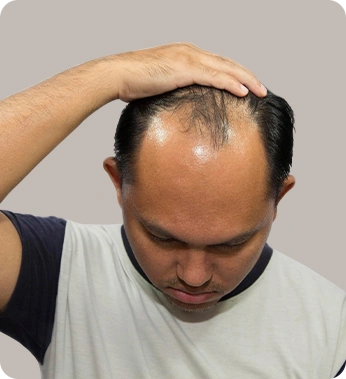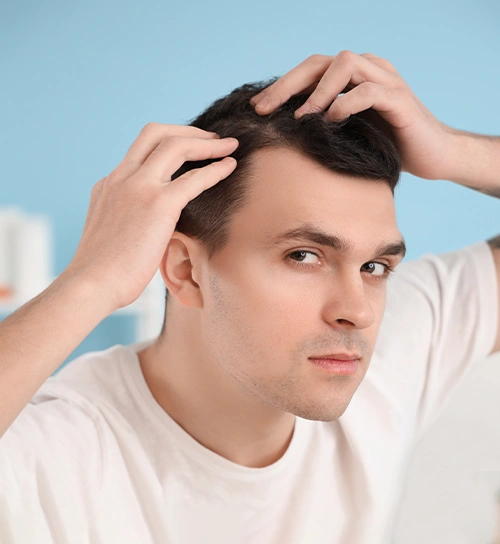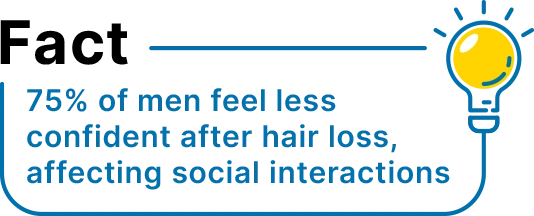Effective Homeopathic Treatment for Male Pattern Baldness
Personalised Treatment for Healthier & Fuller Hair
Book your Appointment
Noticing your hair thin or your hairline recedes can be challenging. It is completely natural to feel concerned. Male pattern baldness is pretty common—it affects 1 in 5 men by age 20, 1 in 4 by 25, globally and nearly half by 50. In fact, more than 90% of hair loss consultations are about this type of baldness.
Homeopathy offers a natural, side-effect-free treatment by balancing hormones, strengthening hair follicles, and stimulating regrowth. Unlike conventional treatments, it targets the root causes and supports long-term hair health. Studies show individualised homeopathic remedies help slow hair loss and promote regrowth when treated early.
At Dr Batra’s®, we know hair loss impacts more than looks. It affects confidence, too.
Personalised Assessments
Patients get a personalised treatment plan after a detailed consultation and scalp analysis using advanced AI-Hair diagnostics
Homeopathy Combined with Advanced Aesthetics
Homeopathy treats the root cause for lasting results, while advanced aesthetics like XOGEN, STM, and groHair deliver visible results in 6 sessions
Holistic Treatment Approach
To give your holistic treatment, we emphasise on your diet/nutrition and hair care tips
Expertise & Experience
90%+ Success Rate, 200+ Clinics, 300+ Doctors, 1.5 Lakhs+ patients treated globally
Measuring Progres
Regular assessments and consultations with senior doctors to track your progress and adjust the treatment if needed


| Approach | Homeopathy | Conventional |
|---|---|---|
| Treats Root Causes | ||
| 100% Natural & No Side Effects | ||
| Works for All Scalp Types | ||
| Safe for Sensitive Skin | ||
| No Hormonal Imbalance Risk |
The Hamilton-Norwood scale helps classify the progression of male pattern baldness:
Stage 1
Your hairline remains intact, with no visible hair loss yet.
Stage 2
A slight recession appears near the temples.
Stage 3
The hairline forms an "M" or "U" shape, and thinning may start at the crown.
Stage 4
Hair loss deepens at the temples and crown, creating visible bald spots.
Stage 5
The bald areas expand, and the gap between the crown and temples narrows.
Stage 6
Only thin strands connect the sides and back, with significant hair loss on top.
Stage 7
A horseshoe pattern remains, with hair only on the sides and back.
Receding Hairline
"M"-shaped hairline, starting at temples
Crown Thinning
Hair loss on the top of the head
Increased Shedding
Noticing more hair fall in the shower, pillow, or comb
Widening Part
The hair part looks noticeably broader
Genetics
Family history of hair loss
Hormonal Imbalances
DHT causes shrinkage of hair follicles
Aging
Hair growth slows as testosterone levels change
Stress
Cortisol imbalance accelerates hair thinning
Medical Conditions
Thyroid disorders, anaemia, or autoimmune diseases
Dr Batra's® offers a scientifically-backed homeopathic treatment for male pattern baldness, with a 96.6% patient satisfaction rate. The treatment focuses on balancing hormones, strengthening hair follicles, and stimulating regrowth, making it a safe and long-term solution for hair loss.
The best homeopathic medicine for male pattern baldness depends on individual symptoms and hair loss patterns. Common remedies include Lycopodium Clavatum for early-stage baldness, Silicea for weak hair roots, and Phosphorus for hair loss with dandruff. Dr Batra's® personalised homeopathy treatment ensures the best remedy for natural hair regrowth.
Homeopathy can effectively slow down male pattern baldness and promote hair regrowth, especially in the early stages. It controls DHT levels, improves scalp health, and strengthens hair roots. Consistent treatment helps in long-term hair retention and prevents excessive thinning.
Results vary based on hair loss severity and body response. Most patients notice reduced hair fall within 3 months and visible hair regrowth within 6 months with consistent homeopathic treatment at Dr Batra's® clinics.
The cost of Dr Batra's® male pattern baldness treatment depends on treatment duration, severity, and personalised medication. Flexible payment options and EMI plans are available to ensure accessibility for all patients seeking homeopathic hair loss treatment.
Yes, homeopathic treatment for male pattern baldness can stimulate hair regrowth, especially in early stages. It strengthens hair follicles, balances hormones, and reduces hair thinning, allowing new, healthy hair to grow naturally.
Male pattern baldness occurs due to genetics, hormonal imbalances, and increased DHT levels, which cause hair follicle shrinkage. Other contributing factors include stress, ageing, nutritional deficiencies, and underlying medical conditions like thyroid disorders.
Men can reduce hair loss by following a homeopathic hair care plan that includes DHT control, scalp nourishment, balanced nutrition, and stress management. Dr Batra's® homeopathy treatment for male pattern baldness provides a personalised and natural solution for hair regrowth and long-term scalp health.